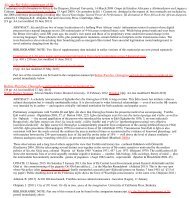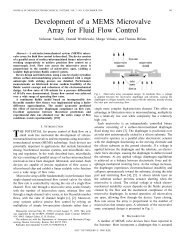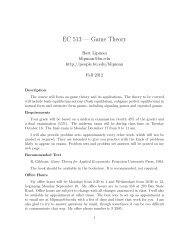CUP2 binds in a bipartite manner to upstream activation sequence c ...
CUP2 binds in a bipartite manner to upstream activation sequence c ...
CUP2 binds in a bipartite manner to upstream activation sequence c ...
You also want an ePaper? Increase the reach of your titles
YUMPU automatically turns print PDFs into web optimized ePapers that Google loves.
454<br />
Fig. 2A, B Mobility shift gel<br />
electrophoresis of <strong>CUP2</strong> and<br />
ace1 bound <strong>to</strong> UASc. A The<br />
au<strong>to</strong>radiograph of a native gel<br />
on which was run the <strong>CUP2</strong>-<br />
UASc complex. In the lanes<br />
on the left the <strong>to</strong>p strand of<br />
UASc is radiolabeled, and <strong>in</strong><br />
the lanes on the right the bot<strong>to</strong>m<br />
strand is radiolabeled.<br />
The outer lanes conta<strong>in</strong> only<br />
ungapped DNA. The other<br />
lanes conta<strong>in</strong> gapped DNA<br />
and <strong>CUP2</strong>. The bands labeled<br />
unbound conta<strong>in</strong> only DNA.<br />
The faster-migrat<strong>in</strong>g prote<strong>in</strong>-<br />
UASc complex is labeled<br />
complex I and the slower is labeled<br />
complex II. B The au<strong>to</strong>radiograph<br />
of a mobility shift<br />
electrophoresis gel on which<br />
was run the ace1-UASc complex.<br />
In the lanes on the left<br />
the <strong>to</strong>p strand of UASc is radiolabeled,<br />
and <strong>in</strong> the lanes<br />
on the right the bot<strong>to</strong>m strand<br />
is radiolabeled. The outer<br />
lanes conta<strong>in</strong> ungapped DNA.<br />
The lanes next <strong>to</strong> the outer<br />
lanes conta<strong>in</strong> gapped DNA.<br />
The rema<strong>in</strong><strong>in</strong>g lanes conta<strong>in</strong><br />
gapped DNA and ace1. The<br />
bands labeled unbound conta<strong>in</strong><br />
only DNA. The faster-migrat<strong>in</strong>g<br />
ace1-UASc complex is<br />
labeled complex I and the<br />
slower one is labeled complex<br />
II<br />
The results of the miss<strong>in</strong>g nucleoside experiment are<br />
<strong>in</strong>terpreted <strong>in</strong> the follow<strong>in</strong>g way. An <strong>in</strong>crease <strong>in</strong> the<br />
amount of DNA <strong>in</strong> a band <strong>in</strong> the unbound fraction <strong>in</strong>dicates<br />
that the loss of this nucleoside <strong>in</strong>hibits formation<br />
of the prote<strong>in</strong>-DNA complex. Correspond<strong>in</strong>gly, a<br />
reduced amount of gapped DNA at a particular <strong>sequence</strong><br />
position <strong>in</strong> the complex I and complex II fractions<br />
<strong>in</strong>dicates that loss of this nucleoside reduces the<br />
formation of these complexes.<br />
Miss<strong>in</strong>g nucleoside analysis of <strong>CUP2</strong><br />
The results of our miss<strong>in</strong>g nucleoside experiments show<br />
that formation of complex II requires that <strong>CUP2</strong> occupy<br />
both half-sites of UASc (Fig. 3). In each half of<br />
UASc we f<strong>in</strong>d a series of bands of reduced <strong>in</strong>tensity,<br />
<strong>in</strong>dicat<strong>in</strong>g that the loss of any of these nucleosides <strong>in</strong>hibits<br />
formation of complex II. For both strands, a region<br />
of reduced band <strong>in</strong>tensity is observed between nucleotides<br />
–119 and –112 <strong>in</strong> the downstream half-site. In the<br />
<strong>upstream</strong> half-site, a longer stretch of DNA, from positions<br />
–129 <strong>to</strong> –142, is required for formation of complex<br />
II.<br />
On the <strong>to</strong>p strand, the nucleosides required for formation<br />
of complex II are found <strong>in</strong> two regions: strong<br />
reductions <strong>in</strong> band <strong>in</strong>tensity <strong>in</strong> the bound fraction are<br />
observed at nucleosides –135 <strong>to</strong> –129, while moderate<br />
reductions <strong>in</strong> band <strong>in</strong>tensity are seen at nucleosides<br />
–142 <strong>to</strong> –140. On the bot<strong>to</strong>m strand, 11 nucleosides between<br />
positions –141 <strong>to</strong> –129 are seen <strong>to</strong> be required for<br />
formation of complex II.<br />
In the DNA fraction obta<strong>in</strong>ed from complex I, we<br />
observe a fairly even cutt<strong>in</strong>g pattern that conta<strong>in</strong>s regions<br />
hav<strong>in</strong>g a small reduction <strong>in</strong> band <strong>in</strong>tensity with<strong>in</strong><br />
each half-site. Bands are slightly lower <strong>in</strong> <strong>in</strong>tensity <strong>in</strong><br />
the <strong>upstream</strong> half-site. Thus, a gap at any s<strong>in</strong>gle nucleoside<br />
with<strong>in</strong> UASc is not sufficient <strong>to</strong> prevent formation







